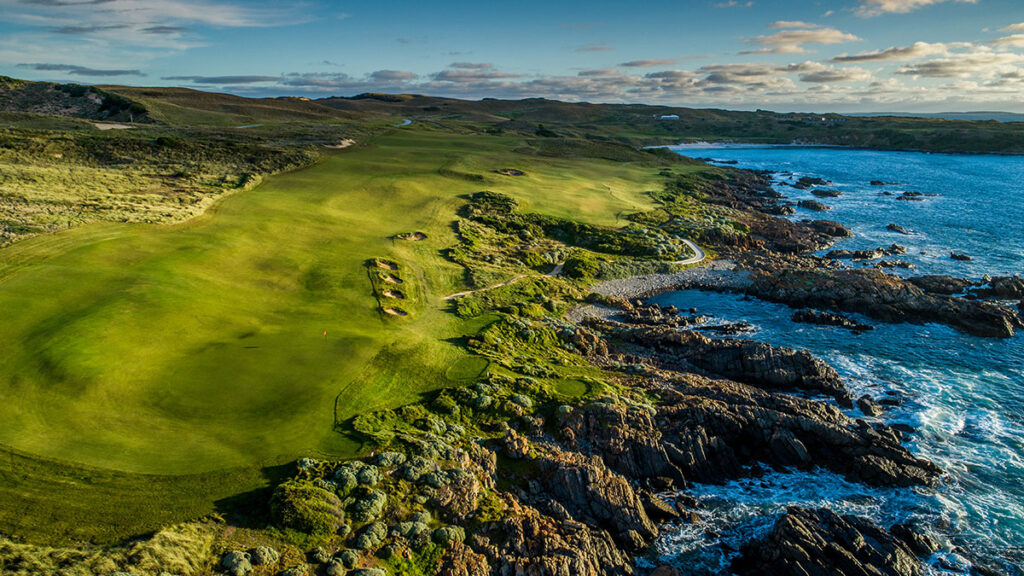Top 100: The King Rises – Australian Golf Digest

- by Admin
- April 24, 2024

A new No.1 is indicative of an ongoing tight tussle at the top in our 19th biennial ranking of Australia’s Top 100 Golf Courses.
In the period spanning our previous ranking two years ago, a queen headed the Commonwealth. Today, a king sits on the throne for the first time since 1952. In a similar monumental shift, we have a new ruler atop our nation’s golf courses.
The difference here is that this is a succession rather than the passing of a monarch, and it may well be temporary. For just the second time in our ranking’s near-40-year history, a course other than Royal Melbourne holds top spot as Cape Wickham Links on Tasmania’s King Island ascends to No.1 for the first time.
It’s a result that will turn heads, induce eyerolls and, no doubt, draw criticism. How can any course other than Royal Melbourne be considered our best? you might ask. There are a few reasons – and none of them are to do with Royal’s revered West course slipping in any way. In fact, the average score returned by our judging panel for the West has gradually risen in the past four rankings. On this occasion, it was simply passed – and by the barest of margins.
Part of it is our fault in that we stopped ranking Royal Melbourne’s Composite after the 2008 list. That instantly diluted its stranglehold on No.1 even if the West course still held it every time bar one. RM viewed as the Composite course alone is almost certainly never unseated from the top, however our decision 15 years ago to separate it into West and East gave it vulnerability.
Save for 2010 – when Kingston Heath rose to No.1, essentially on the back of a period of prolonged drought and water issues at Royal Melbourne – the West course has remained untouched until now. Yet the writing was on the wall. In the 2018 ranking, the scores separating the top four courses were exceptionally close. There was no change in order then, but there easily could have been.
Cape Wickham didn’t become No.1 overnight and this is far from an inflated ranking based on novelty and newness. We saw this coming.
“Perennial bridesmaid Kingston Heath and newcomer Cape Wickham are breathing down its neck,” we wrote in the space six years ago, “and, based on the average points they accrued this year and last time, either one could usurp mighty Royal Melbourne in the future. It might be a one-off or a permanent coronation, but we’ll flag here that it can most definitely happen.”
Even two years ago, we posed the question about the chances of a new No.1. Yet this is less a case of Royal Melbourne sliding, rather a slowly percolating appreciation of Cape Wickham. Its scores from our panel have mostly risen each time since it opened in late 2015, while it has required time to permeate the Australian – and international – golf scene. That a public course is ranked No.1 for the first time is another accomplishment to celebrate.

The criteria debate
Is there too much emphasis placed on scoring according to our seven judging criteria? That will be the reaction of some who don’t agree with the new No.1. And indeed this was a usurping performed largely through the Aesthetics category, where Cape Wickham brings to the table the one thing Royal Melbourne can’t: an out-of-this-world location. It is just one measurement out of seven, and worth a mere 12.5 percent of the total score, but it has an impact.
We’ve also been here before. When Kingston Heath took top spot in 2010, we earned some scorn from within the golf fraternity for having the perceived audacity to demote Australia’s best golf course, but I distinctly recall phoning Royal Melbourne’s then general manager – the late, great Paul Rak – ahead of the on-sale date to break the news. His response? “I couldn’t believe we’d stayed No.1 last time.”
There was more change in this ranking, although in a much more behind-the-scenes way. In the wake of the COVID-impacted 2022 ranking – when our panel generated only just enough scores for a valid outcome – we drastically expanded the size of our judging panel and ordered them to see more golf courses, and not just the incumbent leading 100. If there’s been a lingering criticism of our ranking process, it’s been a lack of visitation in places. That cry is thrown out the door this time. A panel of 277 collectively visited 809 different Australian golf courses – that’s more than half the 1,603 we have – and returned 7,026 total evaluations. There is more data behind this ranking than any before it [see panel, page 79]. As such, what we call “The Next 100”, those courses ranked 101 to 200, will be far more comprehensive when that list is revealed in the June issue.
Elsewhere on the 2024 ranking, 49 courses improved their position compared to 2022. That’s partly due to the deliberate omission of a record number of courses as substantial redesign projects remain in vogue, promising a series of compelling returns in 2026. Another nine courses returned to this Top 100 after periods of varying duration spent on the outer.
It’s a moment to be proud of for all 100, although we know the focal point of this result will be at the summit. This particular queen’s reign has ended; how long the new king rules becomes the next question.

The 2024 ranking, by the numbers
- 277 panellists
- 809 courses scored
- 7,026 total evaluations
- 72.62 score for the No.1 course (out of 80)
- 0.22 the gap between No.1 and No.2
- 10.32 the gap between No.1 and No.50
- 4.88 the gap between No.51 and No.100
The Latest News
-
December 22, 2024Tiger Woods’ son Charlie makes a hole-in-one in the final round of the PNC Championship – Australian Golf Digest
-
December 22, 2024Tennis’ love match: Meet ‘Aussie’ Matteo Arnaldi and his Melburnian girlfriend
-
December 22, 2024GEORGIE PARKER: McSweeney was McStiff to get axed
-
December 22, 2024Chris Eubanks picks the ATP player he considers a real dark horse to win the Australian Open
-
December 22, 2024Time for the Swedish chef: Ikea’s furniture profits are down in Australia, but food sales are booming





